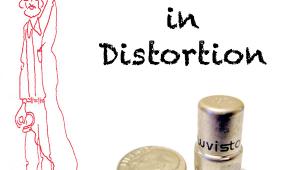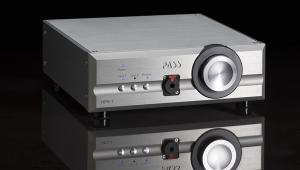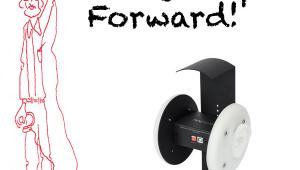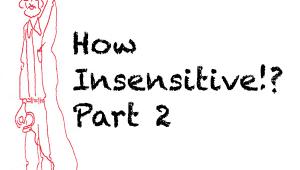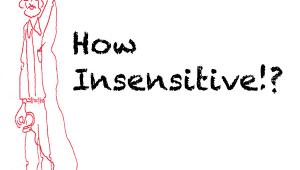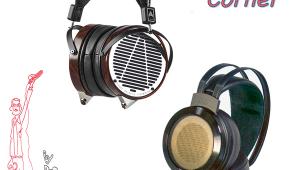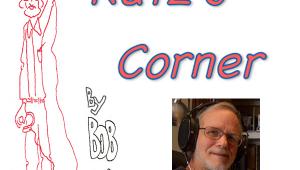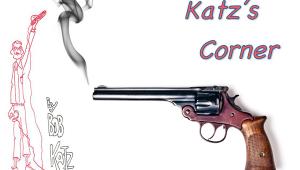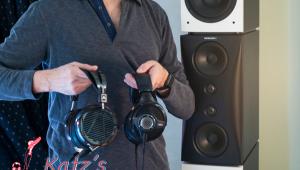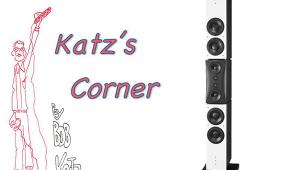| Columns Retired Columns & Blogs |
Katz's Corner, Episode 6: Things Are Looking Up

This story originally appeared at InnerFidelity.com
The High Res Mafia
In a previous episode I alluded to some 2496 master versions of albums which I have mastered which are currently available "only" on CD. When these 2496 versions become available to the public, they will sound warmer, purer, and even a bit more dynamic than the 1644 versions. But, and this is an important but: if you are a member of the "true high res mafia" that's watching over the high sample rate recordings being issued by HD tracks, then you will not permit some of these masters I've made from seeing the light of day at HD tracks. This is because the high res mafia spend their days watching FFT displays to confirm that there is high frequency information above 22.05 kHz in the high sample rate recordings they can buy. Given that our ears can't even detect frequencies above 20 kHz, those who claim we "sense" these ultrasonic frequencies are probably skating on thin ice. However, I am certain that sound quality improves when we sample at higher rates.
So, what gives? What gives is that when you play back a PCM recording, a filter must be placed in the circuit to remove imaging artifacts that are above half the sample rate (the Nyquist frequency). In the case of 44.1 kHz, that filter cuts off sharply at 22.05 kHz. Some designers are experimenting with gentler filters which probably sound better, but have to choose between two tradeoffs. One is that some imaging artifacts can come through (which causes alias distortion) or the other is that frequencies below 22.05 kHz will be reduced. And when frequencies between 10 kHz and 20 kHz are reduced, it is audible. So 44.1 kHz sampling is a compromise in sound quality no matter how you look at it. The higher sample rates permit using gentler filters, which probably sound better, but without cutting off the frequency response in the audible region.
OK, back to the mafia. HD tracks has obeyed the mafia so they have to guarantee that any high sample rate recording they sell has a high sample rate provenance. That's pretty sad, because my ears tell me that when I have upsampled my recordings for processing at the beginning of the mastering chain, they sound better when played at the higher rate. Quite simply, it's because two unnecessary sharp filters have been removed from the signal chain. There are other advantages to mastering at higher rates: alias distortion is reduced when performing non-linear digital domain processing, converters seem to tolerate clipping with fewer artifacts, the sound is purer. So that's your loss, because you'll not be able to hear my incredible recordings as I meant them to be reproduced. You're going to have to listen to my masters at (usually) 1644, which not only has the sharp filtering in the DAC, but also has been reduced in wordlength to fit on a compact disc. Every time I reduce the rate at the end of my mastering chain, I notice losses in sound quality. I wish the mafia would go away, or at least that HD tracks would permit these upsampled recordings, and label their provenance to be fair to consumers. For they do sound better when reproduced at the higher rate. Maybe they don't sound as good as original high rate recordings, but still, they sound significantly better than recordings which were mastered at the lower rate.
Another Serious Look at the Stax Phones
I often use analog processing when mastering, especially with pop music. Analog processors can enrich and color the sound in a pleasant way. A little bit of controlled distortion can increase depth. Analog EQs have their own character. Tubes and transformers can all be part of the mastering process. That is, if a recording sent in for mastering needs that kind of processing. Purists would scorn the idea of going out to analog processing during mastering, but it's a fact that mastering engineers often use analog processing to sweeten the sound. All of Doug Sax's best records have been mastered with a superb analog custom-built tube chain. Many of Bob Ludwig's records he's mastered over the last 40 years have been processed via analog, lately using some SPL-brand processors with high-headroom 120 volt opamps. Perhaps 70% of the pop records I master go through some form of analog processing, 20% strictly through digital processing and 10% receive no processing at all. The latter are recordings which were recorded and mixed so well that any form of post-processing takes them downhill. The 20% are recordings which need a completely transparent mastering approach and the 70% of pop recordings are the recordings which benefit from some form of analog sweetening to sound their best. Many of my clients are mixing totally "in the box" (digitally) and they often tell me that they crave some of that analog sound that I can provide. I wouldn't pass the signal through an analog chain unless it truly enhances a recording as there are many fine recordings which go downhill when they are not handled as transparently as possible.
In order to process via analog, I have to send the signal out a DAC, into analog processors, and then return into an ADC. Ideally that part of the chain should add no coloration or change the sound. I leave the rest of the coloring to my choice of analog processors. There doesn't seem to be a totally transparent pair of converters but I am always looking for that holy grail. Recently I found a pair of converters which are audibly closer to the source than my previous converters. But converters have gotten so good that I actually thought my previous set was transparent. I didn't notice any losses when feeding a source through D-A-D and monitoring on my high resolution Revel speakers. But I was wrong. On loudspeakers I didn't notice a difference, but when I performed the shootout listening through my Stax Omega IIs fed by the KGSS amp. Oh my... that's when I discovered that my previous converter favorites were obviously closing in the sound a bit, losing a bit of ambience and space. And I learned that the new converter pair was more transparent, much closer to the sound of the source. I then tried every dynamic phone that I have, and discovered that I had lost that microscope, that ability to discern fine differences in ambience and space! The differences between converters was far less obvious on any of my dynamic headphones, just as it was with my speakers. On the speakers I had to search for a difference and could easily fool myself. The Stax are also great at judging distortion in recordings.
What makes the Stax such an audio microscope? I wager it's their higher transient response and superior impulse response (the speed and fidelity with which the drivers react to short changes in sound pressure) and also the high frequency extension. I'm loving my Stax, at least when I want to make an analytical judgment. I still love my Audeze — they have the cojones which even Stax with a bass boost cannot quite provide. However, the Stax are quite musical. I would surmise that a system we would label "analytical" would also not sound musical, but that is not the case with the Stax. What's your opinion?
The Fabulous O2 Headphone Amplifier
When possible, I'm an audio cheapskate. I make (terminate) my own cables and swear by the performance of an admittedly cheap but good audio cable: Mogami AES/EBU cable used for analog, of course! It's about 30 cents per foot. I buy what equipment sounds good regardless of price, and that could mean low or high (if I can afford it). Which makes Tyll's recent goody package especially attractive: a collection of mid-priced headphones for evaluation. In preparation for this assignment I decided to supplement my expensive Burson Soloist headphone amplifier with a low-priced model. Tyll and others have written about the O2 amp so I purchased a slightly-customized unit from JDS labs for $177. I could have saved about $50 and built the kit which they so nicely supply but I judged that my labor and time to build the kit would certainly outweigh the $50 savings. Let me add my praise for the O2 to Tyll's and Steve Guttenburg's: It's a fabulous amp. It's transparent yet very slightly on the sweet side (which I like) and has plenty of impact and headroom at least for my sensitive LCD-Xs. I measured at least 10 dB lower THD than the Burson soloist at the equivalent of 120 dB SPL (LCD-X) into a 20 ohm load, below 1 kHz, slowly rising to about the same as the Burson above 1 kHz. O2 THD (without noise) measures using Room EQ Wizard 0.002% up to 1 kHz while the Burson measures 0.006% (still a trifle). Here's a comparison of the THD curves of the two amplifiers:
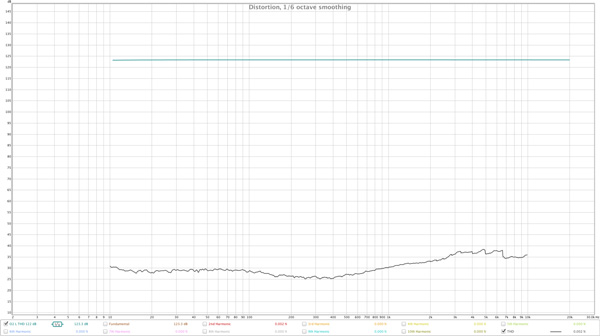
Fig 12: JDS Labs O2 amplifier THD (without noise) at 123 dB equivalent SPL into 20 ohms (0.1 W, 1.414 VAC at 1 kHz). 0.002% THD below 1 kHz rising to about 0.005% at 10 kHz.
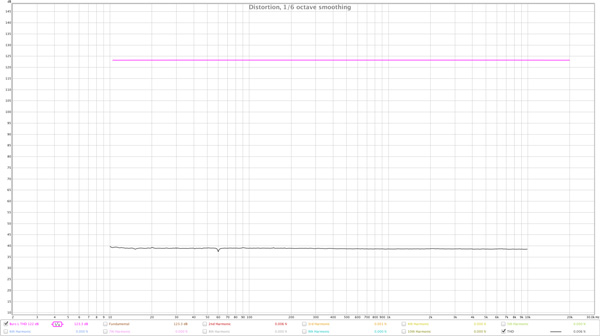
Fig 13: Burson Soloist THD (without noise) at 123 dB equivalent SPL into 20 ohms (0.1 W, 1.414 VAC at 1 kHz). 0.006% THD from 10 Hz to 10 kHz.
Here is a comparison [figure 14] of the two amps' 19/20 kHz IM distortion at 103 dB equivalent SPL into 20 ohms (1 mW). Burson in green, O2 in Red. As you can see, the average noise floor of the Burson is about 12 dB better than that of the O2 but it exhibits considerable hum and noise spikes. The Burson has an internal toroidal transformer while the O2 is externally powered, and I believe the evidence points to the much cheaper amp having a much cleaner power supply as far as hum spikes go. But the general noise floor of the Burson (Gaussian noise) is much lower. However, both amps' noise and distortion floors are well below the threshold of hearing. The equivalent SPL into a very sensitive headphone is less than -4 dB SPL: let me repeat, less than minus 4 dB SPL! Since this is so far below the threshold of hearing, we have to question whether any of these measurement graphs are indications of the sonic character of the amps, or just red herrings.
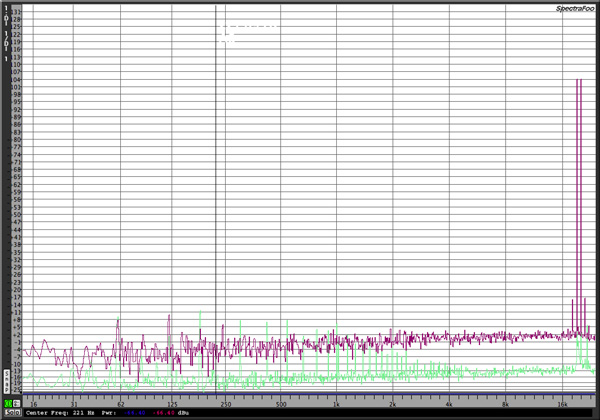
Fig. 14: 19/20 kHz IM distortion at 103 dB equivalent SPL into 20 ohms (0.001 W, 0.1414 VAC at 1 kHz) Burson Soloist, green, O2 Red.
Output impedance of the Burson is so low it’s virtually immeasurable, below 1 ohm, as was the O2, where I cal-culated about 0.8 ohm output impedance at 1 kHz. An interesting phenomenon is the input stage of the O2 goes into clipping almost before the output, at the high gain setting. Input clips above about 2.4 VAC at 1 kHz at the high gain setting, so I reduced the source voltage until it produced 0.001% THD+N at 1 kHz, which yielded 4.4 VAC into 20 ohms with the volume control near maximum, just below output clipping. This is almost 1 watt, which would produce almost 133 dB SPL with the LCD-X, more than enough to go deaf! So this amp has more than adequate output level. Is one watt/20 ohms the sweet spot for headphone amps?
I'm sitting on the fence about what these facts could mean; I do think the O2 sounds more transparent than the Burson, and that the Burson has a tubelike character, so depending on your ancillary equipment and headphone choice, one amp will sound better to you under some conditions. Ultimately I found that both amps are very nice and my preferences depended on what I wanted to listen to on a given day. But there's no question that the JDS O2 is one of the best bargains in the audiophile headphone world today. I may sound like a reverse audio snob, but I'd like to pit the O2 against amps costing many times the price, at matched gains.
Episode 7 Preview
Most pro music engineers are far more frugal than me. I'm privileged to own two exotic high priced cans and the Stax and Burson amps. Just a crazy indulgence enabled by living frugally in so many other ways and having an understanding wife. But still I'm always very interested in what can be bought for "under $700" in headphones and amps (I love a bargain, if it sounds good), and to that end, today a wonderful care package arrived courtesy of Tyll: A box of midprice headphones from assorted manufacturers. The principle is quite simple: We're looking for Nirvana—cheap! Somewhere in that box we hope to find a real good but cheap set of cans, maybe more than one. Will that be by accident, design, or just the law of averages? I recall that over the years every one of the Sony headphone models I bought had a completely different flavor. Never the same sound twice, even in the follow up to the same Sony model. It was very disturbing because the MDR V-6 did not sound remotely like the V5's that I first discovered, loved and used for remote film and TV shoots or knock-around in the studio. It seemed that every Sony headphone of that era was designed and tuned by a different engineer; you never knew what you were gonna get. Same thing with JBL loudspeakers; over the years, never the same way twice! But now JBL seems to be on a consistent course, we'll see how the LSR professional models mature as they tweak 'em. Right now I think the LSRs need some more transparency, they seem weighted and logy to me.
But I digress. I do hope that these midpriced headphone brands Tyll sent for my review will exhibit a continuous family resemblance as one model succeeds another, provided these models sound good to begin with. I'll use the O2 and the Burson as a comparison and reference to the Stax and the Audeze LCD-X as well as my incredible loudspeaker system. I'm also planning on building an M3 headphone amp from AMB with a souped-up 40 volt power supply, in hopes of proving my contention that headroom does make a difference, and to have a higher powered "neutral" amp in my stable. In upcoming Katz's Corner episodes, audio pros and frugal audiophiles can find out what you can buy for "under $700", versus a "cost-no-object" alternative. Interesting times are ahead.
(Ed Note: Very much looking forward to your impressions, Bob. For readers: As I recall there are eight headphones in the box: Sennheiser Momentum 2; NAD VISO HP50; Audio Technica ATH-MSR7 and ATH-M50x; Focal Spirit Pro; Shure SRH1540; B&W P7; and Oppo PM3.)
- Log in or register to post comments
